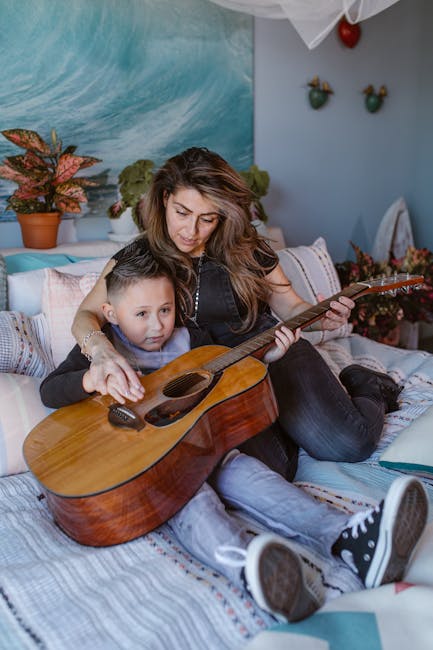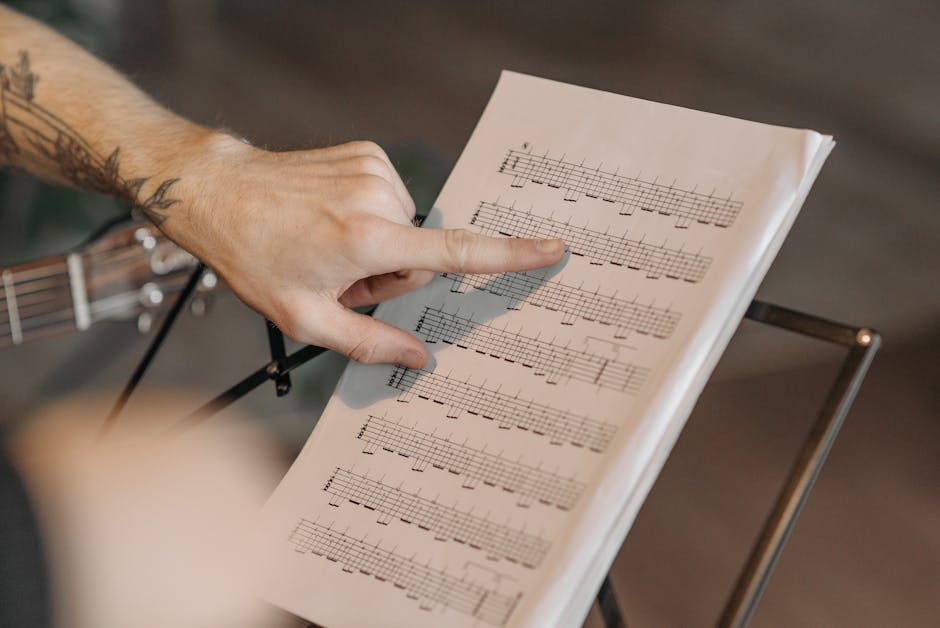So you’ve decided to pick up the acoustic guitar and become the next rock star sensation, huh? Well, before you start shredding like a superstar, you’ll need to master the basics – starting with your first chords. Don’t worry, we’ve got your back with this crash course on essential acoustic guitar basics. Grab your pick, tune up, and get ready to strum your way to musical greatness!
Contents
- 1 Understanding the Anatomy of Your Acoustic Guitar
- 2 Tuning Your Instrument for Optimal Performance
- 3 Familiarizing Yourself with the Most Common Chords
- 4 Developing Proper Finger Placement and Strumming Techniques
- 5 Practicing Chord Transitions Smoothly and Efficiently
- 6 Incorporating Simple Songs to Reinforce Your Chord Mastery
- 7 Overcoming Common Challenges for Beginning Guitarists
- 8 FAQs
- 9 Time to Strum Like a Pro!
Understanding the Anatomy of Your Acoustic Guitar
So, you’ve got yourself an acoustic guitar and you’re ready to strum away like a rockstar. But do you actually know what you’re strumming on? Let’s take a closer look at the anatomy of your trusty six-stringed companion.
First up, we’ve got the body of the guitar. This is where all the magic happens – the sound hole, the bridge, the saddle, and, of course, the pickguard to protect your precious instrument from scratches (and your questionable strumming technique).
Next, let’s talk about the neck of the guitar. This is where you’ll find the fretboard, frets, and tuning pegs. It’s basically the highway to guitar heaven – or in my case, the road to inevitable finger calluses.
And last but not least, we’ve got the headstock. This is where you’ll find the tuning keys, the nut, and the truss rod. It’s like the control center of your guitar – except for when you inevitably break a string and have to frantically re-tune everything before your next acoustic jam session.
Tuning Your Instrument for Optimal Performance
When it comes to playing an instrument, getting the best performance out of it is key. One way to ensure you’re hitting all the right notes is by tuning your instrument properly. Here are some tips and tricks to help you make the most out of your musical companion:
- Start by investing in a good quality tuner. Sure, you can try to tune by ear, but why risk hitting a sour note when you can have a handy little device do all the work for you?
- Make sure to tighten or loosen your strings gradually. You don’t want to be left with a broken string and a broken heart because you couldn’t contain your excitement while tuning.
Don’t forget to check the intonation of your instrument. This is often overlooked, but it can make a world of difference in how your instrument sounds. You don’t want to be the musician that everyone avoids because your instrument sounds like a cat screeching in the dead of night.
Lastly, remember that tuning is an ongoing process. Your instrument will constantly be affected by changes in temperature, humidity, and even how hard you play it. So make sure to give it some love and attention regularly to keep it at peak performance. And hey, who knows, maybe one day you’ll be the next Jimi Hendrix or Beethoven!

Familiarizing Yourself with the Most Common Chords
Okay, so you’ve decided to pick up that dusty guitar in the corner and finally learn how to play it. But where do you start? Well, let’s start by familiarizing yourself with some of the most common chords that you’ll come across in your musical journey. And trust me, once you get these down, you’ll be well on your way to playing all your favorite tunes.
First up, we have the C major chord. This one is a classic and a great place to start. It’s a simple three-finger chord that will open up a world of possibilities for you. Next, we have the G major chord. This one might be a little trickier at first, but with some practice, you’ll have it down in no time. And let’s not forget about the D major chord. Sure, it might seem daunting with all those fingers, but once you nail it, you’ll feel like a rock star.
Now, don’t be intimidated by all these fancy names. Just remember that practice makes perfect. And before you know it, you’ll be strumming away like a pro. So grab that guitar, dust off those strings, and get ready to impress your friends with your newfound chord knowledge. Who knows, maybe you’ll even start your own band!
So there you have it, a quick rundown of some of the most common chords you’ll encounter. Now go forth, my musical friend, and conquer those frets with confidence. And remember, the journey to becoming a guitar god starts with just a few simple chords.

Developing Proper Finger Placement and Strumming Techniques
When it comes to , it’s important to remember that practice makes perfect. You may feel like a chicken pecking at a cornfield at first, but with perseverance, you’ll soon be strumming like a rockstar!
One tip to keep in mind is to always keep your wrist loose and relaxed. Think of it as a floppy noodle, not a rigid wooden spoon. This will help you achieve a smooth and natural strumming motion that will make your chords sing.
Another trick is to use the pads of your fingers, not the tips. Pretend you’re giving a gentle massage to the strings, not trying to poke holes in them. This will help you produce a clean and clear sound with each strum.
And finally, don’t be afraid to experiment with different strumming patterns and techniques. Mix it up with some upstrokes and downstrokes, throw in a couple of mutes for good measure, and before you know it, you’ll be strumming your way to musical greatness!
![]()
Practicing Chord Transitions Smoothly and Efficiently
Transitioning between chords smoothly is like trying to navigate a minefield – one wrong move and your whole performance can blow up in your face. But fear not, aspiring guitar gods and goddesses! I have some tips and tricks up my sleeve to help you master those chord changes like a pro.
First things first, practice makes perfect. Spend some quality time with your guitar and really get to know those chords inside and out. The more familiar you are with the finger placements, the easier it will be to switch between them seamlessly. Think of it like a dance – you wouldn’t expect to twirl your partner around flawlessly on the first try, would you?
Next, make sure your fingers are in the right position before you even attempt to strum that chord. This might sound like common sense, but it’s all too easy to rush ahead and end up with a jumbled mess of notes. Take your time, check your fingers, and then rock out like the guitar hero you were born to be.
Lastly, experiment with different fingerings for the same chord. Sometimes a simple switch of a finger can make all the difference in how smoothly you can transition between chords. Don’t be afraid to get creative and find what works best for you. Remember, Rome wasn’t built in a day - and neither was that awesome guitar solo you’ve been dreaming of. Keep practicing, keep pushing yourself, and soon enough you’ll be shredding like a rock star.
Incorporating Simple Songs to Reinforce Your Chord Mastery
Have you been feeling a bit stuck in your chord mastery journey? Well, fear not my musical friend, because I have a quirky idea for you to try out! Instead of grinding away at those complex chord progressions, why not incorporate some simple songs into your practice routine?
By learning and mastering simple songs, you can reinforce your understanding of basic chords and their transitions. Plus, these songs are usually catchy tunes that will stick in your head like a bad jingle. Just imagine rocking out to “Twinkle, Twinkle, Little Star” on your guitar like a true rockstar!
So, dust off that old nursery rhyme book and start strumming away. Who knows, maybe you’ll even discover a newfound appreciation for the classics. And remember, practice makes perfect, even if you’re playing “Mary Had a Little Lamb” for the hundredth time.
And if all else fails, just channel your inner Childish Gambino and put a funky twist on “Row, Row, Row Your Boat.” Trust me, your chord mastery will thank you for it!
Overcoming Common Challenges for Beginning Guitarists
So you’ve picked up the guitar and decided to become a rock star, huh? Well, get ready to face some common challenges that all beginning guitarists encounter. But fear not, with a little perseverance and a lot of practice, you can overcome these hurdles and become a guitar hero in no time!
First up, those pesky calluses on your fingertips. Yes, they may be painful at first, but think of them as battle scars that prove your dedication to the guitar. Embrace the pain and soon enough, you’ll have fingers of steel that can shred like a true rock god. Plus, chicks dig calloused fingertips, right?
Next, the dreaded barre chords. Trying to press down all six strings with one finger feels like trying to hold onto a greased pig – slippery and frustrating. But fear not, with practice and determination, you’ll soon be nailing those barre chords like a pro. Just remember, Rome wasn’t built in a day, and neither was Jimi Hendrix’s guitar playing.
Finally, the never-ending battle with tuning your guitar. It seems like every time you pick up your guitar, it’s out of tune. But hey, that’s just part of the charm of playing an instrument. Invest in a good tuner, learn how to tune by ear, or just embrace the chaos and call it your own unique tuning. Who knows, you might just stumble upon the next big sound in music!
FAQs
Can I start learning acoustic guitar without any prior experience?
Absolutely! As long as you’re willing to put in the time and effort to practice, anyone can start learning acoustic guitar regardless of their experience level. Just remember, even the greats had to start from zero at some point.
What are some essential chords that beginners should master first?
Some essential chords for beginners to master include the basic open chords like G, C, D, E, and A. These chords are not only easy to learn but also widely used in many popular songs, making them a great starting point for beginners.
How can I improve my chord transitions and strumming?
Improving your chord transitions and strumming takes practice, practice, and more practice. Start by practicing switching between chords slowly and gradually increase your speed as you become more comfortable. Focus on keeping a steady rhythm and strumming pattern to improve your overall sound.
Should I use a pick or play with my fingers?
Whether you choose to use a pick or play with your fingers is a matter of personal preference. Some guitarists prefer the crisp sound of a pick while others enjoy the softer tone of playing with their fingers. Experiment with both techniques to see which feels more comfortable for you.
How can I prevent my fingers from hurting when learning new chords?
It’s common for beginners to experience discomfort in their fingers when first learning to play guitar. To prevent pain, make sure to stretch your fingers before playing, take breaks when needed, and build up calluses over time. Remember, no pain, no gain!
What are some good beginner songs to practice with these essential chords?
Some good beginner songs to practice with these essential chords include classics like “Wonderwall” by Oasis, “Horse with No Name” by America, and “Knocking on Heaven’s Door” by Bob Dylan. These songs are not only fun to play but also a great way to practice your chord transitions and strumming.
Time to Strum Like a Pro!
So there you have it, budding guitarists! With these essential chords under your belt, you’re on your way to becoming a master of the acoustic guitar. Remember, practice makes perfect, so keep strumming away and soon enough you’ll be rocking out like a pro. And who knows, maybe one day you’ll be headlining at Madison Square Garden! So pick up that guitar, start practicing those chords, and get ready to serenade the world with your musical talents. Happy strumming!



